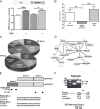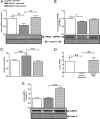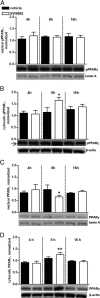Cognitive enhancement with rosiglitazone links the hippocampal PPARγ and ERK MAPK signaling pathways
- PMID: 23175826
- PMCID: PMC3574637
- DOI: 10.1523/JNEUROSCI.2153-12.2012
Cognitive enhancement with rosiglitazone links the hippocampal PPARγ and ERK MAPK signaling pathways
Abstract
We previously reported that the peroxisome proliferator-activated receptor γ (PPARγ) agonist rosiglitazone (RSG) improved hippocampus-dependent cognition in the Alzheimer's disease (AD) mouse model, Tg2576. RSG had no effect on wild-type littermate cognitive performance. Since extracellular signal-regulated protein kinase mitogen-activated protein kinase (ERK MAPK) is required for many forms of learning and memory that are affected in AD, and since both PPARγ and ERK MAPK are key mediators of insulin signaling, the current study tested the hypothesis that RSG-mediated cognitive improvement induces a hippocampal PPARγ pattern of gene and protein expression that converges with the ERK MAPK signaling axis in Tg2576 AD mice. In the hippocampal PPARγ transcriptome, we found significant overlap between peroxisome proliferator response element-containing PPARγ target genes and ERK-regulated, cAMP response element-containing target genes. Within the Tg2576 dentate gyrus proteome, RSG induced proteins with structural, energy, biosynthesis and plasticity functions. Several of these proteins are known to be important for cognitive function and are also regulated by ERK MAPK. In addition, we found the RSG-mediated augmentation of PPARγ and ERK2 activity during Tg2576 cognitive enhancement was reversed when hippocampal PPARγ was pharmacologically antagonized, revealing a coordinate relationship between PPARγ transcriptional competency and phosphorylated ERK that is reciprocally affected in response to chronic activation, compared with acute inhibition, of PPARγ. We conclude that the hippocampal transcriptome and proteome induced by cognitive enhancement with RSG harnesses a dysregulated ERK MAPK signal transduction pathway to overcome AD-like cognitive deficits in Tg2576 mice. Thus, PPARγ represents a signaling system that is not crucial for normal cognition yet can intercede to restore neural networks compromised by AD.
Figures




References
-
- Ahi J, Radulovic J, Spiess J. The role of hippocampal signaling cascades in consolidation of fear memory. Behav Brain Res. 2004;149:17–31. - PubMed
-
- Alessi DR, Gomez N, Moorhead G, Lewis T, Keyse SM, Cohen P. Inactivation of p42 MAP kinase by protein phosphatase 2A and a protein tyrosine phosphatase, but not CL100, in various cell lines. Curr Biol. 1995;5:283–295. - PubMed
-
- Atkins CM, Selcher JC, Petraitis JJ, Trzaskos JM, Sweatt JD. The MAPK cascade is required for mammalian associative learning. Nat Neurosci. 1998;1:602–609. - PubMed
-
- Bell KA, O'Riordan KJ, Sweatt JD, Dineley KT. MAPK recruitment by beta-amyloid in organotypic hippocampal slice cultures depends on physical state and exposure time. J Neurochem. 2004;91:349–361. - PubMed
Publication types
MeSH terms
Substances
Grants and funding
LinkOut - more resources
Full Text Sources
Miscellaneous
